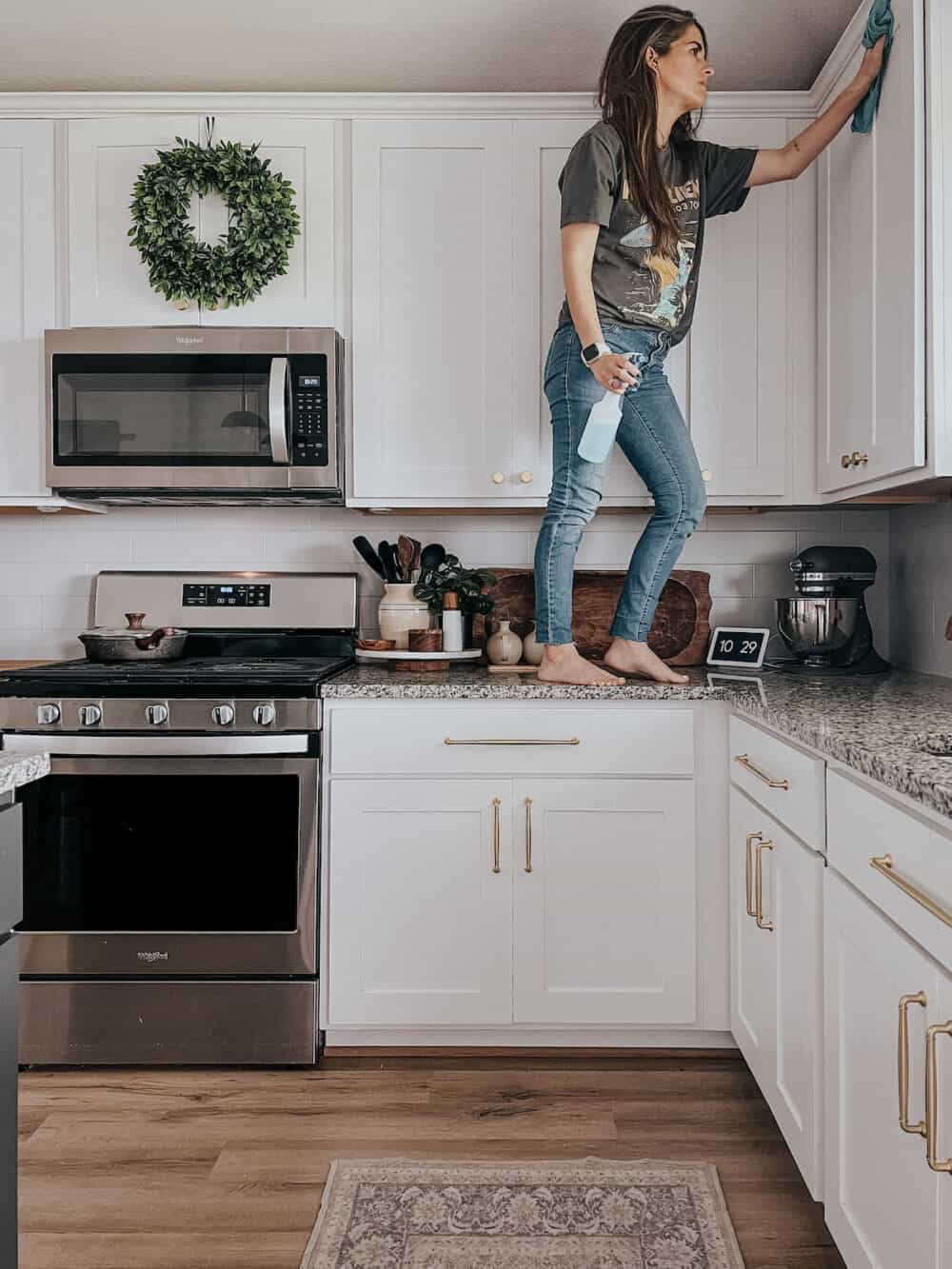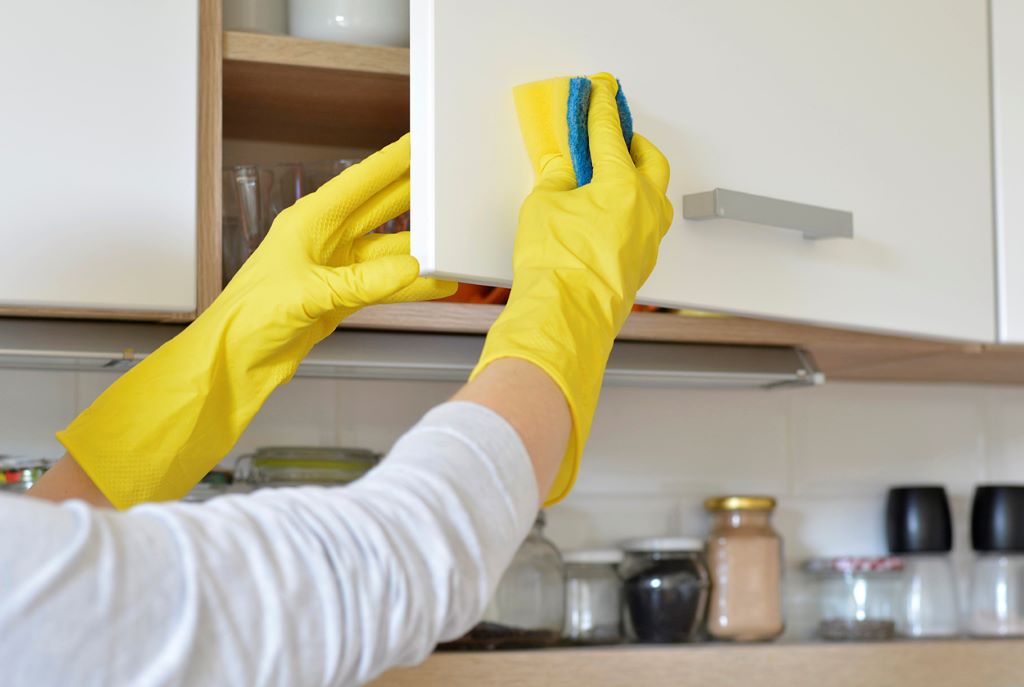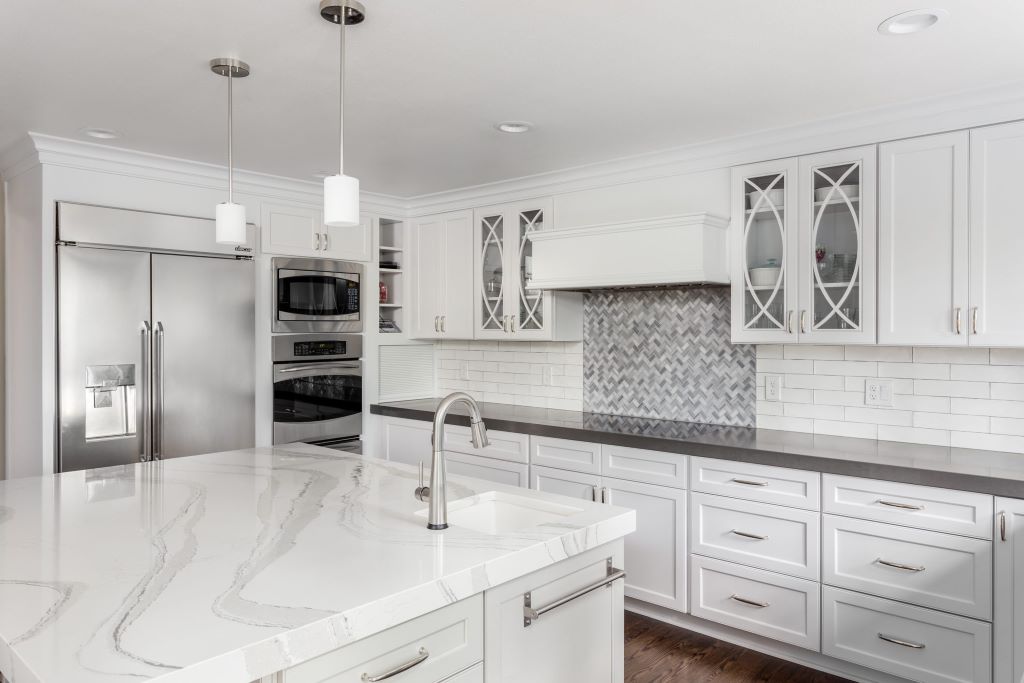
21 Dec How to Clean White Kitchen Cabinets
White kitchen cabinets can look gorgeous when they’re sparkling clean. However, they do require regular cleaning to keep them looking pristine. Over time, grease, dust, and grime can build up and make your white cabinets appear dull and dirty. The good news? With the right cleaning solutions and techniques, I can teach you how to clean white kitchen cabinets and have them look new again. This comprehensive guide will provide tips on basic upkeep, deep cleaning methods, and troubleshooting for stubborn stains. Let’s get started!
Supplies You’ll Need
Before we dive into the step-by-step instructions, you’ll want to gather the necessary cleaning supplies. Having these items ready will make the process faster and more efficient.
- Microfiber cloths
- Soft bristle brush
- Dish soap or other mild detergent
- All-purpose cleaner
- Baking soda
- White vinegar
- Baby oil or olive oil
- Toothbrush (for tight spaces)
- Disposable rags
- Clean bucket or basin
- Rubber gloves
- Eye protection glasses
- Step stool (if needed)
I recommend stocking up on microfiber cloths—they are lint-free, ultra absorbent, and perfect for buffing and polishing. Steer clear of paper towels as they can leave behind fibers and lint.

Basic Cleaning Tips for Upkeep
What’s the best way to clean white kitchen cabinets on a regular basis?
Get into a solid cleaning routine. Quick mini cleans make a big difference in maintaining fresh, dirt-free cabinets. I recommend tackling cabinets the same day you cook. Allow 10-15 minutes after dinner for a swift wipe-down. Here are some go-to methods:
Clear Clutter and Remove Food Items
Start by clearing flat surfaces and removing food items from cabinets. It’s easier to clean clear spaces. Check for expired products and throw away anything past its prime.
Use a Damp Microfiber Cloth
Wipe down exterior cabinet surfaces using a damp lint-free microfiber cloth. Pay special attention to handles and knobs where greasy buildup accumulates.
Spot Clean With Dish Soap
For isolated dirt or grime, apply a small amount of dish soap to a wet sponge. Gently rub the soiled area using minimal pressure. Buff dry using a clean microfiber cloth.
Disinfect With a Multi-Surface Cleaner
Once or twice per week, give cabinets a light wipe down using an antibacterial all-purpose cleaner. This will kill germs and leave surfaces sparkling clean.
Let’s move onto the nitty gritty deep cleaning tips…
Deep Cleaning White Kitchen Cabinets
What method should you use to deeply clean white kitchen cabinets?
For a seasonal deep clean or any time buildup appears, be prepared to put some muscle into the process. White kitchen cabinets may look gorgeous but they do require some periodic heavy-duty cleaning.
Here are my top tips for tackling stained or grimy cabinets:
Remove Cabinet Doors
Start by detaching doors and removing shelves. Place door fronts flat on a protected work surface. Take out food items and wipe down shelving using a microfiber cloth.
Mix a Cleaning Solution
Grab your bucket and make a cleaning solution of mild dish soap or detergent with warm water. You’ll also need separate containers for vinegar, baking soda, and bleach solutions (for tougher stains).
Scrub With a Soft Bristle Brush
Use a soft bristle brush and your cleaning solution to scrub the cabinet box exteriors along with door fronts, sides, handles, and hinges. Apply extra elbow grease on oily areas but be gentle overall to avoid scuffing surfaces.
Rinse thoroughly and follow up by spot treating any remaining stains. We’ll go over specific stain removal techniques in the next section.
Clean and Polish Glass
Fill another bucket with warm water and add a small amount of vinegar, which will help cut through grease and water spots. Using a microfiber cloth, wash glass cabinet inserts until squeaky clean. Polish dry with a fresh lint-free cloth.
Freshen Interiors
Grab some disposable rags and give cabinet interiors a good wipe down. Use a toothbrush to scrub out dirt and debris hiding in corners and crevices. Finish by sanitizing with an antibacterial spray.
Once fully dry, you can reattach doors, replace shelves, and restore food items. Admire your gleaming white kitchen cabinets!
Troubleshooting Tough Stains
What homemade solutions can treat tough stains on white kitchen cabinets?
Even with regular cleaning, it’s common for white cabinets to develop difficult stains that resist basic soap and water. Before you splurge on replacing doors or repainting, try these homemade remedies first:
Baking Soda Paste
Baking soda works wonders to lift stubborn grease. Make a paste by mixing baking soda with just enough water to form a spreadable consistency. Using a soft bristle brush, gently rub the paste onto stained areas for 2-3 minutes. Rinse and dry completely.
Lemon Juice
To remove yellowing or dinginess, apply fresh lemon juice directly onto affected spots. Let it sit for a few minutes before wiping away. The natural acidity in lemons acts as a brightener.
Vinegar Solution
For eliminating funky odors or mild mildew stains, mix equal parts white vinegar and water in a spray bottle. Lightly mist over surfaces, allow to sit for 15 minutes, then blot dry with a clean cloth.
Olive Oil
Cabinet hinges often attract dirt buildup. Carefully use an oil-dampened toothbrush to gently brush and loosen debris from crevices. Wipe away grime with a soft rag. Finish with a soapy wash.
Bleach-Water Mix
For tougher grease or grime that won’t budge, carefully apply a diluted bleach solution using disposable gloves. Make sure to rinse surfaces thoroughly after use. Bleach can damage surfaces if left too long.

Maintenance Tips to Prevent Dirt Buildup
What are some everyday habits that can keep cabinets cleaner longer?
An ounce of prevention is worth a pound of cure when it comes to white kitchen cabinet maintenance. Making a few minor daily tweaks can dramatically cut down on cleaning time. Here are some effortless habits to prevent dirt and grime buildup:
- Designate a “dirty dishes” zone in your kitchen away from white cabinetry to avoid splatter and overflow mess on cabinet fronts.
- Install knob silencers onto cabinet door handles to reduce fingerprints and smudging. These small clear bumpers prevent metal-on-metal contact.
- Open a window, turn on your vent hood, or run a fan when cooking greasy foods like bacon or fried eggs. Proper kitchen ventilation sucks up moisture, fumes, and airborne grease that would otherwise settle onto cabinet surfaces.
- Keep your kitchen thoroughly dry after spills, flooding, or leaks with an industrial dehumidifier. Moisture invites mold, which leaves black and green stains.
- Apply car wax onto cabinet fronts 1-2 times per year as you would a car. Wax leaves behind a protective barrier that repels moisture, oil, and grime.
- Avoid placing small kitchen appliances like toasters and coffee machines directly underneath cabinets. Steam and food splatter contribute to greasy buildup over time.
FAQs
- Can I use wood cleaner on white cabinets?
White kitchen cabinets have a laminate coating so standard wood cleaners are too harsh. Stick to mild dish soap, vinegar, or antibacterial sprays instead.
- Should white cabinets be cleaned with bleach?
In moderation, yes. Make sure to heavily dilute bleach with water first. Test on an inconspicuous spot and limit contact time. Rinse surfaces extremely well afterward.
- How do you clean greasy cabinets without removing them?
Use degreasing solutions like lemon juice or baking soda paste. Apply directly onto grease, allow to penetrate for 2-3 minutes, scrub with a soft bristle brush, and wipe away grime using a damp microfiber cloth.
- What is the easiest way to clean cabinets?
For routine upkeep, the easiest approach is using microfiber cloths dampened with warm water and a small amount of mild dish detergent or antibacterial spray.
- How often should you deep clean cabinets?
Plan to deeply clean cabinets every 6-12 months using the steps outlined above. Seasonal deep cleaning keeps surfaces fresh in between quick wipe downs.
In Conclusion
I hope you feel fully equipped to clean your white kitchen cabinets like a pro!
To recap, be sure to:
- Gather the recommended cleaning supplies
- Stay on top of daily and weekly surface wipe downs
- Deep clean fully at least 1-2 times per year
- Spot treat isolated stains as needed
- Modify daily habits to prevent dirt buildup over time
White kitchen cabinets add beautiful brightness. Four natural ways to eliminate insects from your kitchen not only ensure a pest-free environment but also contribute to the long-lasting sparkle of your cabinets; with some periodic heavy lifting and elbow grease, maintaining this focal point keeps your whole kitchen looking its best for years to come!



Sorry, the comment form is closed at this time.